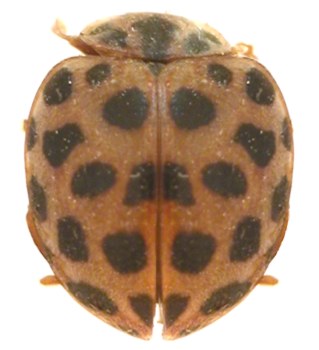Pests
Epilachna vigintioctomaculata Motsch. - 28-spotted Potato Ladybird
Systematic position.
Class Insecta, order Coleoptera, family Sossinellidae, subfamily Epilachninae, genus Epilachna.Biological group.
These are olygophagous pests of solanaceous crops.Morphology and biology.
Body of beetle is nearly rounded, convex, shiny, 4-7 mm long. Elytra are brown-yellow, with 14 black spots on each elytron. Eggs are yellow, about 1.5 mm long; they are placed on lower sides of leaf in groups of 10-65 eggs. Body of larva and pupa is oval, yellow-green, with black branchy thorns. Length of larva is 1.5 (I instar) to 6 mm (IV instar); the length of pupa is 5-6 mm. Beetles and larvae live openly on plants, eating soft tissues of leaves between veins. Average fertility of female is 300-400, maximum to 1400 eggs. Under average conditions of the Primorskii Territory and southern part of Khabarovsk Territory the eggs develop in 6-10 days, larvae in 18-24 days on optimal host plant (potato), pupae in 6-9 days. Larvae pupate on leaves. Young beetles of new generation feed intensively for 1-2 weeks to form fatty tissue; later on they diapause and winter. Only imagoes are capable of wintering; they usually hibernate under the fallen leaves at forest edges or in bushes, and also in fields under plant residues.Distribution.
E. vigintioctomaculata is an aboriginal species in the southern part of the Russian Far East. Its area includes the Primorskii Territory (especially the valley of Ussuri river, the coastline of Japan Sea and foothills), the southern parts of the Amur Region and Khabarovsk Territory (north to 52°N), the Sakhalin and Kuril Islands. Since the second half of the 20th century the area of this species has been increasing northward, westward, and eastward within the Amur Region and Khabarovsk Territory. The species lives in the north-east of China, in Northern Korea and Japan in addition to Russia.Ecology.
E. vigintioctomaculata is a monovoltine species. Emergence of over-wintered beetles begins at an average daily temperature of +13°C (in May usually), continuing for 2-3 weeks. These beetles propagate from the beginning of June until August. Larvae hatching in various periods develop from the middle of June until September; pupae develop from July until September. Young imagoes of the summer generation may be observed in fields from the end of July until October. This species is relatively hygrophilous. The optimum conditions for its reproduction and development are air temperature 18-24°C and air humidity 75-100%. Therefore, the Potato Ladybird is most abundant and harmful in marshy low-lying localities in valleys of big rivers (such as Amur, Ussuri, etc.) or during warm rainy seasons in more dried biotopes. E. vigintioctomaculata causes damage to agricultural crops of 3 families, i.e., Solanaceae (potato, eggplant, tomato, red pepper, etc.), Cucurbitaceae (cucumber, melon, water-melon, pumpkin, etc.), and Fabaceae (soya bean, haricot bean). But only the potato is the optimal host plant for the reproduction of over-wintered beetles and for larval development. The foliated potato varieties having broad leaf lobes and being without toxic substances are especially favorable for the pest, whereas the tomatoes and cucumbers are considerably less favorable. The young beetles of the summer generation are more polytrophic. They often emerge after potato harvesting, feeding on vegetable and leguminous crops before they diapause.Economic significance.
E. vigintioctomaculata causes the most damage to potato, especially early-ripening varieties of early sowing. Larvae and young beetles during the first 5 days after their emergence are the most voracious and harmful. The economical threshold of harmfulness for this pest is two over-wintered beetles per 10 potato plants. The yield losses of potato tubers often reach 25% in the zone of high damage and to 10% in the zone of low (inconsistent) damage of the pest.Preventive and protective measure include preferential growing of resistant varieties of plants; maintenance of crop rotation with a spatial isolation of solanaceous and pumpkin cultures; placing of solanaceous crops in open windy localities at some distance from forests and groves; utter destruction of all plant residues. If the pest population density exceeds economical threshold the use of permitted insecticides is recommended according to regulations.
Reference citations:
Ivanova A.N. 1962. The Potato Ladybird in the Far East. Vladivostok: Primorskii Publishing House. 53 p. (In Russian)Kaz'min G.T., ed. 1977. Potato Production in the Far East. Khabarovsk: Publishing House. 175 p. (In Russian)
Kiselev E.P., Novoselov A.K. 1977. Resistance to 28-spotted Potato Ladybird. In: Kaz'min G.T., ed. Proc. Far-Eastern Agric. Res. Inst. V. 23. Khabarovsk: Far-Eastern Agric. Res. Inst. 68-69 p. (In Russian)
Shabliovskii V.V. 1964. 28-spotted Potato Ladybird. In: Polyakov I.Ya., Chumakov A.E., eds. Proc. VIZR. V. 22. Leningrad: VIZR. 301-304 p. (In Russian)
Shabliovskii V.V., Gusev G.V. 1964. Potato Ladybird. Zashchita rastenii 2: 24-25. (In Russian)
Shapiro I.D. 1985. Immunity of field crops to insects and mites. Leningrad: Zool. Inst. AS USSR. 321 p. (In Russian)
Shtundyuk A. 1968. Potato Ladybird. Kartofel' i ovoshchi 5: 39. (In Russian)
Simakova T.P. 1978. Influence of temperature and photoperiod on increase of larvae of the 28-spotted Potato Ladybird. In: Ievlev L.A., ed. Biology of some species of pest and useful insects of the Far East. Vladivostok: DVNTs An SSSR. 127-130 p. (In Russian)


